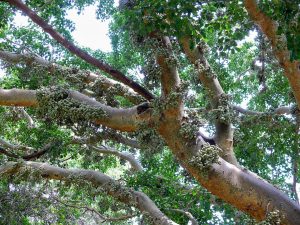Viewing ‘keystone’ species as networking-hubs for interactions within an ecosystem
As city-dwellers, if we had to describe a forest, we would be talking about a wild space with lots of trees, shrubs, herbs and climbers densely packed, growing atop one another. Thousands of insects, birds, herbivores, snakes and lizards sprawled all across. Close enough?
More often than not, we are accustomed to looking at trees as a part of such a forest. But there are also trees out there, which are micro-forests all by themselves! It would be unfair to look at these trees simply as individuals.
Taking the example of a Sycamore Fig in the African forest.

Banyan Tree. Image Credits Fallon Michael from Unsplash
The Sycamore Fig could be compared to the Banyan or Peepal trees that we are so accustomed to in India. As mighty as these species are, they would not be able to produce any fruit if not for a minuscule ant-like insect called a fig-wasp. And the fig-wasps’ survival is interlinked with the pollination of these figs.
The specificity in this interaction is so high that a single species of wasp only pollinates a single species of fig. A “Banyan Wasp” cannot, and will not, pollinate a Peepal tree and vice versa. And this isn’t a recent phenomenon. This has been happening way before mankind appeared on the face of the Earth.
While the Banyan and Peepal are better known members of the family, the Indian sub-continent is home to over 80 species of fig or Ficus trees. Needless to say, each of them is associated with a different species of fig-wasp.
Pause, and take a couple of minutes to digest that.

Sycamore Fig. Image Credits: Bernard Dupont from Flickr
Besides the wasp, the Sycamore Fig also holds space for ants that protect it from parasitic wasps and protect Hilda, another bug. Nematodes or roundworms within the body of the female wasp that help in pollinating the flowers. Cicadas that feed on the tree’s sap. Monkeys that snack on the ripe fruits. Hornbill couples that nest within the trunk and hatch their eggs. Hundreds of other species of birds that hang around to feed on the fruits and insects. The activity around this tree is so high that it also makes space for elephants who come by to feed on fruits, leaves and twigs.
And when the sun goes down, the fruit bats party through the night!
An oft-repeated lesson in permaculture is that every element performs multiple functions. The Sycamore Fig is an example of how a single tree can hold space for all of these processes and creatures to thrive simultaneously. Learn more about this Queen of Trees here.
Trees such as the Sycamore Fig and the other figs are known as ‘keystone species’. These are “individual” species that act like a networking-hub for the fauna/ micro-fauna. Little Forests.
Now, while we definitely do not want to bring the jungle into our streets/backyards, we do have the option of allowing for some of these interactions to continue, don’t we?
While these species could very well be called linchpins in their own right, it would be wrong for us to expect them to replace the wheel altogether. We need a whole range of interrelated species to come together and hold space for an ecosystem to emerge. And this is just the beginning.
Reflection:
What if we looked at ourselves as micro-ecosystems too?
About 50% of what we refer to as the “Self” are just microbes.
And the numbers are in a constant flux depending on how we interact with our environment.
(That’s where the scientists have gotten to so far – Click Here)

